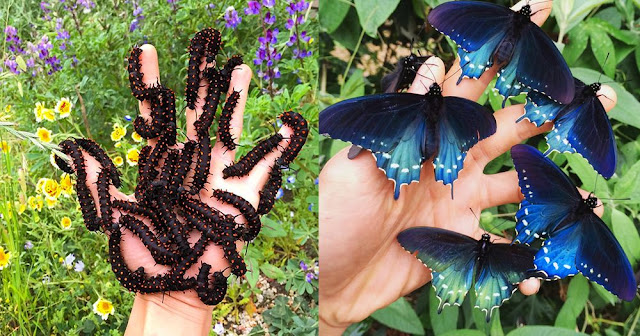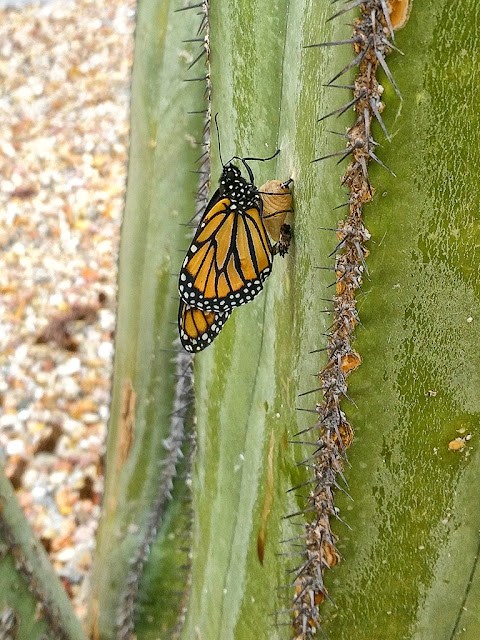~ Ellen DeGeneres
A total of 21 hand-reared Monarchs have been released at the Container Butterfly Garden for the 2016 butterfly garden season through September. Since then, things have slowed way down around here butterfly-wise from barely perceivable to next to nothing. I decided to call it quits early this year cage rearing Monarch cats, as a dearth of these harvestable creepy crawlies was the norm for the last half of the 2016 butterfly season.
From all indications, tachinid fly parasitism was rampant this year, at least in Orange and San Diego counties. From correspondence with others -- especially in San Diego County -- it was a grab all the eggs you can scrounge up before they turn into fly fodder. Without egg harvesting and the subsequent release of healthy adults, the container garden would not have seen any signs of Monarch caterpillars, save the few at the beginning of the season back in March/April, before the tachinids arrived. That would make a cool sci fi movie title: Arrival of the Tachinids.
About the only thing that has been happening here is general plant maintenance, with very few patrons visiting. I'm rather disappointed at the general lack of butterfly visitors to the garden, as I assumed many would show up if enticed. Alas, such is not the case. Situated in a veritable landscape desert devoid of trees and basic landscape plants (Gravel Landscape Mobile Home Park syndrome, or GLMHP as I prefer to call it), there are much better hunting grounds surrounding the mobile home park, so they circumvent it completely. As with politicians, they follow the money.
There may be some major changes coming down the road that will affect the Container Butterfly Garden and this newsletter if things turn out like I would like them to. I put my house up for sale and will be submitting an offer on a home in Prescott Valley, Arizona. Real estate selling/buying contingencies prevail.
If the move happens, I'll be creating a new butterfly garden over there in USDA zones 7 & 8 that I've never gardened in before, hoping to lure butterflies we normally don't see here in SoCal, and of course, some of those we do. I was amazed at how many butterflies I did see cruising around in the various parts of the valley I visited back in November.
From all indications, tachinid fly parasitism was rampant this year, at least in Orange and San Diego counties. From correspondence with others -- especially in San Diego County -- it was a grab all the eggs you can scrounge up before they turn into fly fodder. Without egg harvesting and the subsequent release of healthy adults, the container garden would not have seen any signs of Monarch caterpillars, save the few at the beginning of the season back in March/April, before the tachinids arrived. That would make a cool sci fi movie title: Arrival of the Tachinids.
About the only thing that has been happening here is general plant maintenance, with very few patrons visiting. I'm rather disappointed at the general lack of butterfly visitors to the garden, as I assumed many would show up if enticed. Alas, such is not the case. Situated in a veritable landscape desert devoid of trees and basic landscape plants (Gravel Landscape Mobile Home Park syndrome, or GLMHP as I prefer to call it), there are much better hunting grounds surrounding the mobile home park, so they circumvent it completely. As with politicians, they follow the money.
There may be some major changes coming down the road that will affect the Container Butterfly Garden and this newsletter if things turn out like I would like them to. I put my house up for sale and will be submitting an offer on a home in Prescott Valley, Arizona. Real estate selling/buying contingencies prevail.
If the move happens, I'll be creating a new butterfly garden over there in USDA zones 7 & 8 that I've never gardened in before, hoping to lure butterflies we normally don't see here in SoCal, and of course, some of those we do. I was amazed at how many butterflies I did see cruising around in the various parts of the valley I visited back in November.
Bits and Pieces:
Parks for Monarchs is a "national strategy" for restoring monarch populations to sustainable levels. (cough-cough... Laguna Beach?)
Parks for Monarchs is a "national strategy" for restoring monarch populations to sustainable levels. (cough-cough... Laguna Beach?)
Why two California farms give me hope for the monarch butterfly
A Prevalence of Ophryocystis elektroscirrha Infections in the Monarch Butterfly...
A very well written, planned and organized school project by Danielle, a 12th-grader from south Orange County, California. I hope she received college scholarship offers for her work.
"Migratory monarchs wintering in California experience low infection risk compared to monarchs breeding year-round on non-native milkweed" is an abstract published on the Oxford Journals site by Oxford University Press. Short and sweet, filled with gooey creamy info and delicious scientific observations.
 |
| -EDF Environmental Defense Fund |
A Prevalence of Ophryocystis elektroscirrha Infections in the Monarch Butterfly...
A very well written, planned and organized school project by Danielle, a 12th-grader from south Orange County, California. I hope she received college scholarship offers for her work.
 |
| -Danielle, grade 12 |
"Migratory monarchs wintering in California experience low infection risk compared to monarchs breeding year-round on non-native milkweed" is an abstract published on the Oxford Journals site by Oxford University Press. Short and sweet, filled with gooey creamy info and delicious scientific observations.






















































